Water Salinity Should Be Reduced for Irrigation to Minimize Its Risk of Increased Soil N2O Emissions
Abstract
:1. Introduction
2. Experiments
2.1. Experimental Design
2.2. Gases Sampling and Analyzing
2.3. Soil Moisture and Salinity Measurement
2.4. Statistical Analysis
3. Results
3.1. Soil Temperature
3.2. Soil Moisture
3.3. Soil Salinity
3.4. N2O Emission Fluxes
3.5. Cumulative N2O Emissions
4. Discussion
5. Conclusions
Author Contributions
Funding
Acknowledgments
Conflicts of Interest
References
- Assouline, S.; Moller, M.; Cohen, S.; Ben-Hur, M.; Grava, A.; Narkis, K.; Silber, A. Soil-plant system response to pulsed drip irrigation and salinity: Bell pepper case study. Soil Sci. Soc. Am. J. 2006, 70, 1556–1568. [Google Scholar] [CrossRef]
- Baath, G.S.; Shukla, M.K.; Bosland, P.W.; Steiner, R.L.; Walker, S.J. Irrigation water salinity influences at various growth stages of Capsicum annuum. Agric. Water Manag. 2017, 179, 246–253. [Google Scholar] [CrossRef]
- Chen, W.P.; Hou, Z.A.; Wu, L.S.; Liang, Y.C.; Wei, C.Z. Effects of salinity and nitrogen on cotton growth in arid environment. Plant Soil 2010, 326, 61–73. [Google Scholar] [CrossRef]
- Letey, J.; Feng, G.L. Dynamic versus steady-state approaches to evaluate irrigation management of saline waters. Agric. Water Manag. 2007, 91, 1–10. [Google Scholar] [CrossRef]
- Caruso, C.; Maucieri, C.; Berruti, A.; Borin, M.; Barbera, A.C. Responses of Different Panicum miliaceum L. Genotypes to Saline and Water Stress in a Marginal Mediterranean Environment. Agronomy 2018, 8, 8. [Google Scholar] [CrossRef]
- Adviento-Borbe, M.A.A.; Doran, J.W.; Drijber, R.A.; Dobermann, A. Soil electrical conductivity and water content affect nitrous oxide and carbon dioxide emissions in intensively managed soils. J. Environ. Qual. 2006, 35, 1999–2010. [Google Scholar] [CrossRef] [PubMed]
- Bernhard, A.E.; Donn, T.; Giblin, A.E.; Stahl, D.A. Loss of diversity of ammonia-oxidizing bacteria correlates with increasing salinity in an estuary system. Environ. Microbiol. 2005, 7, 1289–1297. [Google Scholar] [CrossRef] [PubMed]
- Kumar, U.; Kumar, V.; Singh, J.P. Effect of different factors on hydrolysis and nitrification of urea in soils. Arch. Agron. Soil Sci. 2007, 53, 173–182. [Google Scholar] [CrossRef]
- Lodhi, A.; Arshad, M.; Azam, F.; Sajjad, M.H. Changes in mineral and mineralizable N of soil incubated at varying salinity, moisture and temperature regimes. Pak. J. Bot. 2009, 41, 967–980. [Google Scholar]
- Reddy, N.; Crohn, D.M. Effects of soil salinity and carbon availability from organic amendments on nitrous oxide emissions. Geoderma 2014, 235–236, 363–371. [Google Scholar] [CrossRef]
- Hou, H.J.; Chen, H.; Cai, H.J.; Yang, F.; Li, D.; Wang, F.T. N2O and CO2 emissions from Lou soils of greenhouse tomato fields under aerated irrigation. Atmos. Environ. 2016, 132, 69–76. [Google Scholar] [CrossRef]
- Ussiri, D.; Lal, R. Global Sources of Nitrous Oxide. In Soil Emission of Nitrous Oxide and its Mitigation; Springer: Dordrecht, The Netherland, 2013; pp. 131–175. [Google Scholar]
- Lognoul, M.; Theodorakopoulos, N.; Hiel, M.P.; Regaert, D.; Broux, F.; Heinesch, B.; Bodson, B.; Vandenbol, M.; Aubinet, M. Impact of tillage on greenhouse gas emissions by an agricultural crop and dynamics of N2O fluxes: Insights from automated closed chamber measurements. Soil Tillage Res. 2017, 167, 80–89. [Google Scholar] [CrossRef]
- Rafique, R.; Anex, R.; Hennessy, D.; Kiely, G. What are the impacts of grazing and cutting events on the N2O dynamics in humid temperate grassland? Geoderma 2012, 181–182, 36–44. [Google Scholar] [CrossRef]
- Repo, M.E.; Susiluoto, S.; Lind, S.E.; Jokinen, S.; Elsakov, V.; Biasi, C.; Virtanen, T.; Martikainen, P.J. Large N2O emissions from cryoturbated peat soil in tundra. Nat. Geosci. 2009, 2, 189–192. [Google Scholar] [CrossRef]
- Maucieri, C.; Zhang, Y.; McDaniel, M.D.; Borin, M.; Adams, M.A. Short-term effects of biochar and salinity on soil greenhouse gas emissions from a semi-arid Australian soil after re-wetting. Geoderma 2017, 307, 267–276. [Google Scholar] [CrossRef]
- Azam, F.; Muller, C. Effect of sodium chloride on denitrification in glucose amended soil treated with ammonium and nitrate nitrogen. J. Plant Nutr. Soil Sci. 2003, 166, 594–600. [Google Scholar] [CrossRef]
- Ghosh, U.; Thapa, R.; Desutter, T.; He, Y.B.; Chatterjee, A. Saline-Sodic Soils: Potential Sources of Nitrous Oxide and Carbon Dioxide Emissions? Pedosphere 2017, 27, 65–75. [Google Scholar] [CrossRef]
- Inubushi, K.; Barahona, M.A.; Yamakawa, K. Effects of salts and moisture content on N2O emission and nitrogen dynamics in Yellow soil and Andosol in model experiments. Biol. Fertil. Soils 1999, 29, 401–407. [Google Scholar] [CrossRef]
- Tsuneda, S.; Mikami, M.; Kimochi, Y.; Hirata, A. Effect of salinity on nitrous oxide emission in the biological nitrogen removal process for industrial wastewater. J. Hazard. Mater. 2005, 119, 93–98. [Google Scholar] [CrossRef] [PubMed]
- Shang, H.L.; Peng, Y.Z.; Zhang, J.R.; Ye, L.; Zhao, K.F. Effects of salinity concentration on N2O production during nitrification (abstract in Chinese). Environ. Sci. 2009, 30, 1079–1083. [Google Scholar]
- Zhang, W.; Zhou, G.W.; Li, Q.; Liao, N.; Guo, H.J.; Min, W.; Ma, L.J.; Ye, J.; Hou, Z.A. Saline water irrigation stimulate N2O emission from a drip-irrigated cotton field. Acta Agric. Scand. 2016, 66, 141–152. [Google Scholar] [CrossRef]
- Kusa, K.; Hu, R.G.; Sawamoto, T.; Hatano, R. Three years of nitrous oxide and nitric oxide emissions from silandic andosols cultivated with maize in Hokkaido, Japan. Soil Sci. Plant Nutr. 2006, 52, 103–113. [Google Scholar] [CrossRef] [Green Version]
- Kallenbach, C.M.; Rolston, D.E.; Horwath, W.R. Cover cropping affects soil N2O and CO2 emissions differently depending on type of irrigation. Agric. Ecosyst. Environ. 2010, 137, 251–260. [Google Scholar] [CrossRef]
- Manalil, S.; Riethmuller, G.; Flower, K. Rapid emission of nitrous oxide from fallow over summer following wetting in a Mediterranean-type environment. Soil Tillage Res. 2014, 143, 130–136. [Google Scholar] [CrossRef]
- Scheer, C.; Wassmann, R.; Butterbach-Bahl, K.; Lamers, J.; Martius, C. The relationship between N2O, NO, and N-2 fluxes from fertilized and irrigated dryland soils of the Aral Sea Basin, Uzbekistan. Plant Soil 2009, 314, 273–283. [Google Scholar] [CrossRef]
- Toma, Y.; Takakai, F.; Darung, U.; Kuramochi, K.; Limin, S.H.; Dohong, S.; Hatano, R. Nitrous oxide emission derived from soil organic matter decomposition from tropical agricultural peat soil in central Kalimantan, Indonesia. Soil Sci. Plant Nutr. 2011, 57, 436–451. [Google Scholar] [CrossRef] [Green Version]
- Yamamoto, A.; Akiyama, H.; Naokawa, T.; Yagi, K. Effect of lime-nitrogen application on N2O emission from an Andosol vegetable field. Soil Sci. Plant Nutr. 2012, 58, 245–254. [Google Scholar] [CrossRef]
- McDaniel, M.D.; Kaye, J.P.; Kaye, M.W. Do ‘hot moments’ become hotter under climate change? Soil nitrogen dynamics from a climate manipulation experiment in a post-harvest forest. Biogeochemistry 2014, 121, 339–354. [Google Scholar] [CrossRef]
- Sponseller, R.A. Precipitation pulses and soil CO2 flux in a Sonoran Desert ecosystem. Glob. Chang. Biol. 2007, 13, 426–436. [Google Scholar] [CrossRef]
- Kontopoulou, C.K.; Bilalis, D.; Pappa, V.A.; Rees, R.M.; Savvas, D. Effects of organic farming practices and salinity on yield and greenhouse gas emissions from a common bean crop. Sci. Hortic. 2015, 183, 48–57. [Google Scholar] [CrossRef]
- Irshad, M.; Honna, T.; Yamamoto, S.; Eneji, A.E.; Yamasaki, N. Nitrogen mineralization under saline conditions. Commun. Soil Sci. Plant Anal. 2005, 36, 1681–1689. [Google Scholar] [CrossRef]
- Rietz, D.D.; Haynes, R.J. Effects of irrigation-induced salinity and sodicity on soil microbial activity. Soil Biol. Biochem. 2003, 35, 845–854. [Google Scholar] [CrossRef] [Green Version]
- Kim, D.G.; Vargas, R.; Bondlamberty, B.; Turetsky, M.R. Effects of soil rewetting and thawing on soil gas fluxes: A review of current literature and suggestions for future research. Biogeosciences 2012, 9, 2459–2483. [Google Scholar] [CrossRef] [Green Version]
- Ma, L.J.; Zhang, W.; Zhang, N.; Zhang, X.; Li, F.C.; Zhang, H.M.; Mao, J.S.; Hou, Z.A. Effects of saline water on soil ammonia-oxidizing bacteria and enzyme activity in cotton field under drip irrigation condition. Xinjiang Agric. Sci. 2015, 51, 2038–2045. [Google Scholar]
- Pereira, L.S.; Oweis, T.; Zairi, A. Irrigation management under water scarcity. Agric. Water Manag. 2002, 57, 175–206. [Google Scholar] [CrossRef]
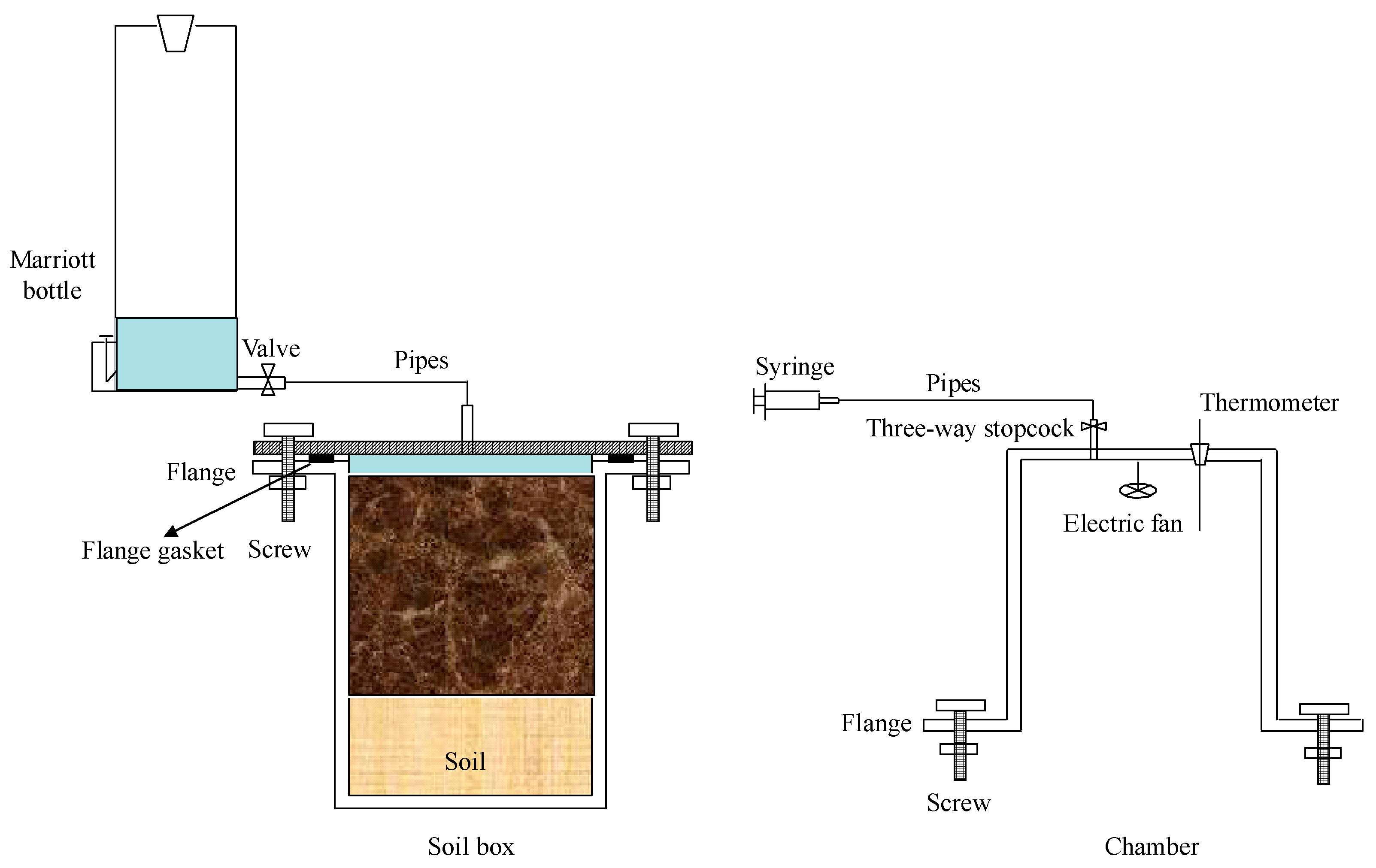
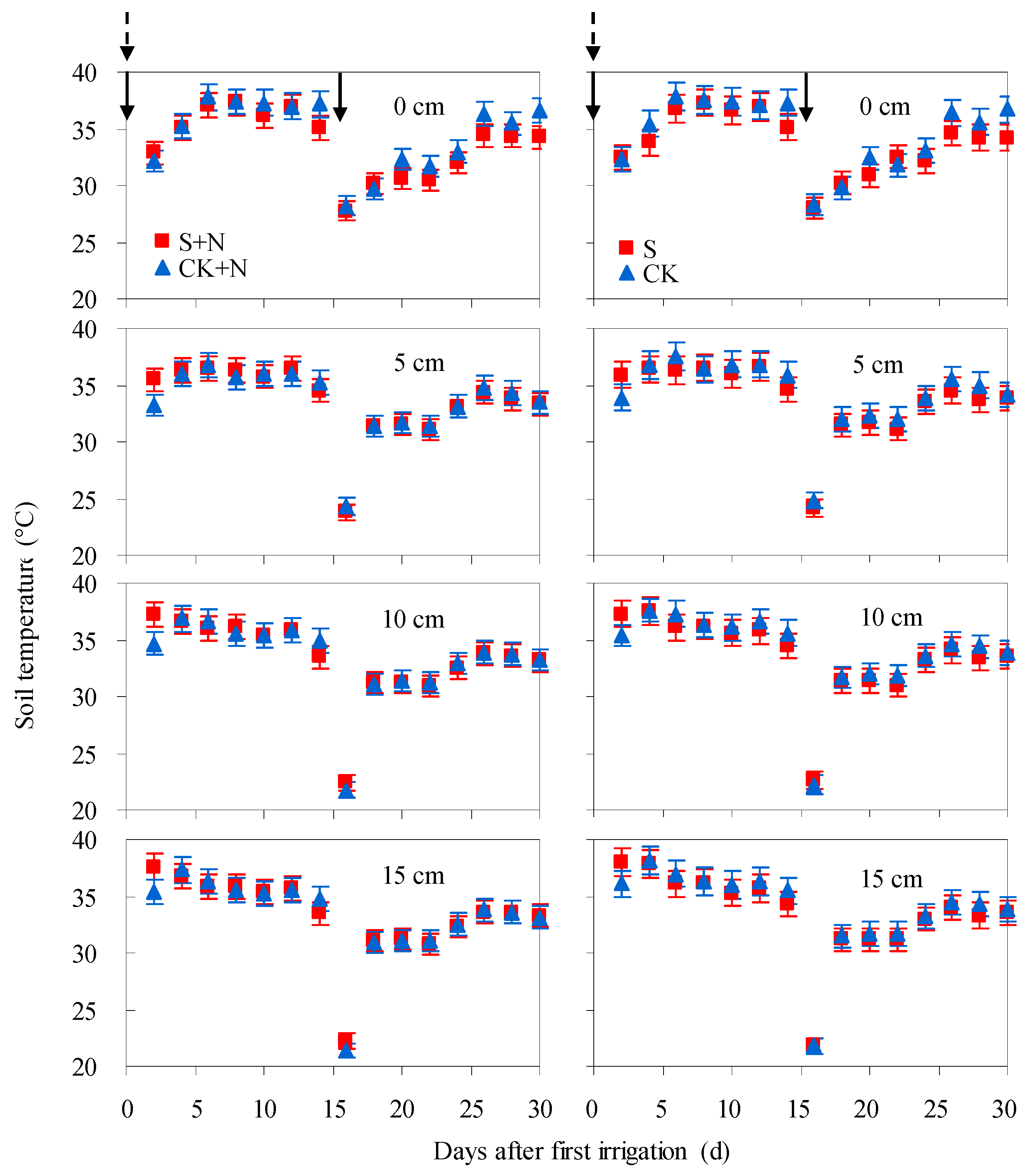
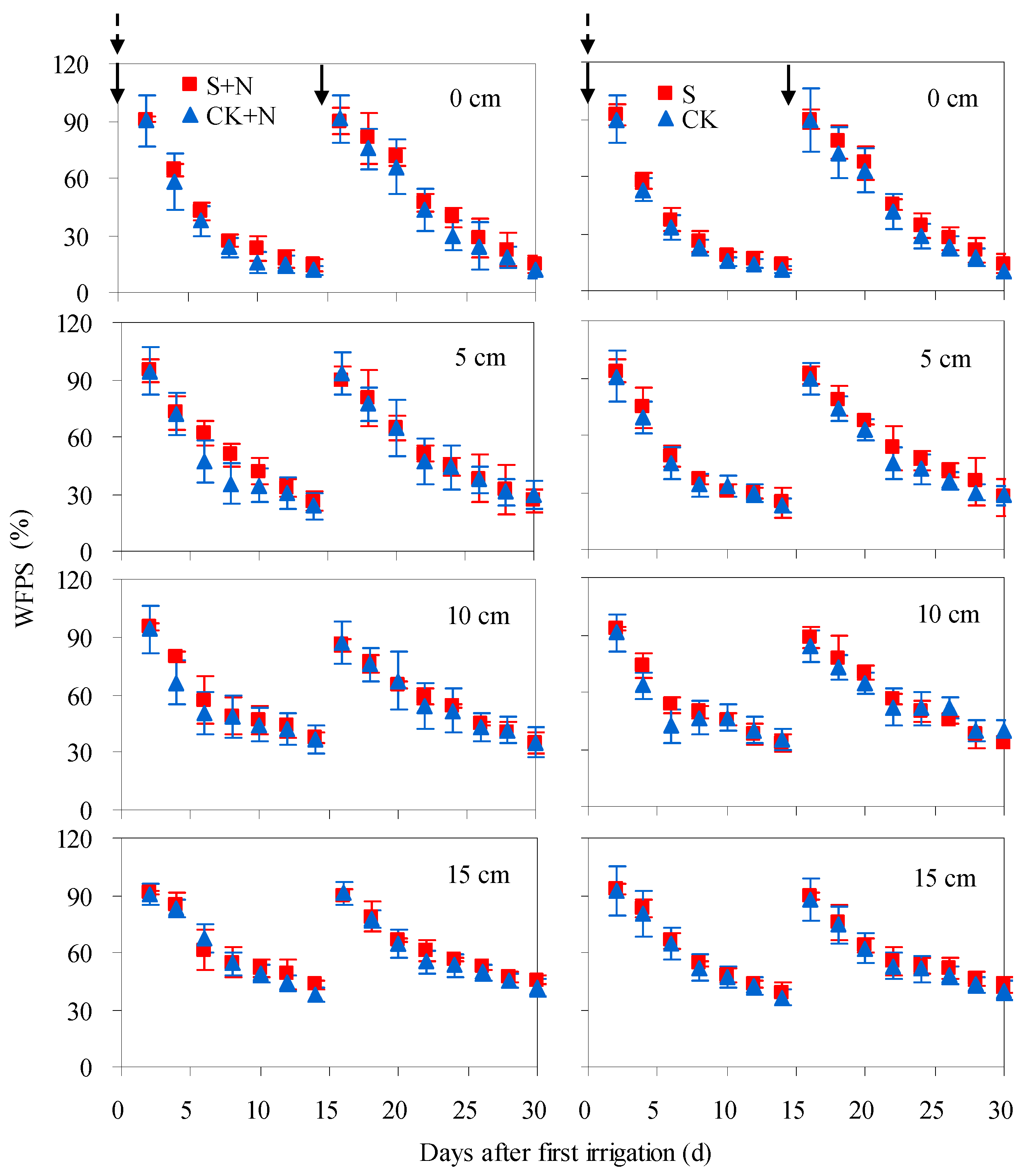
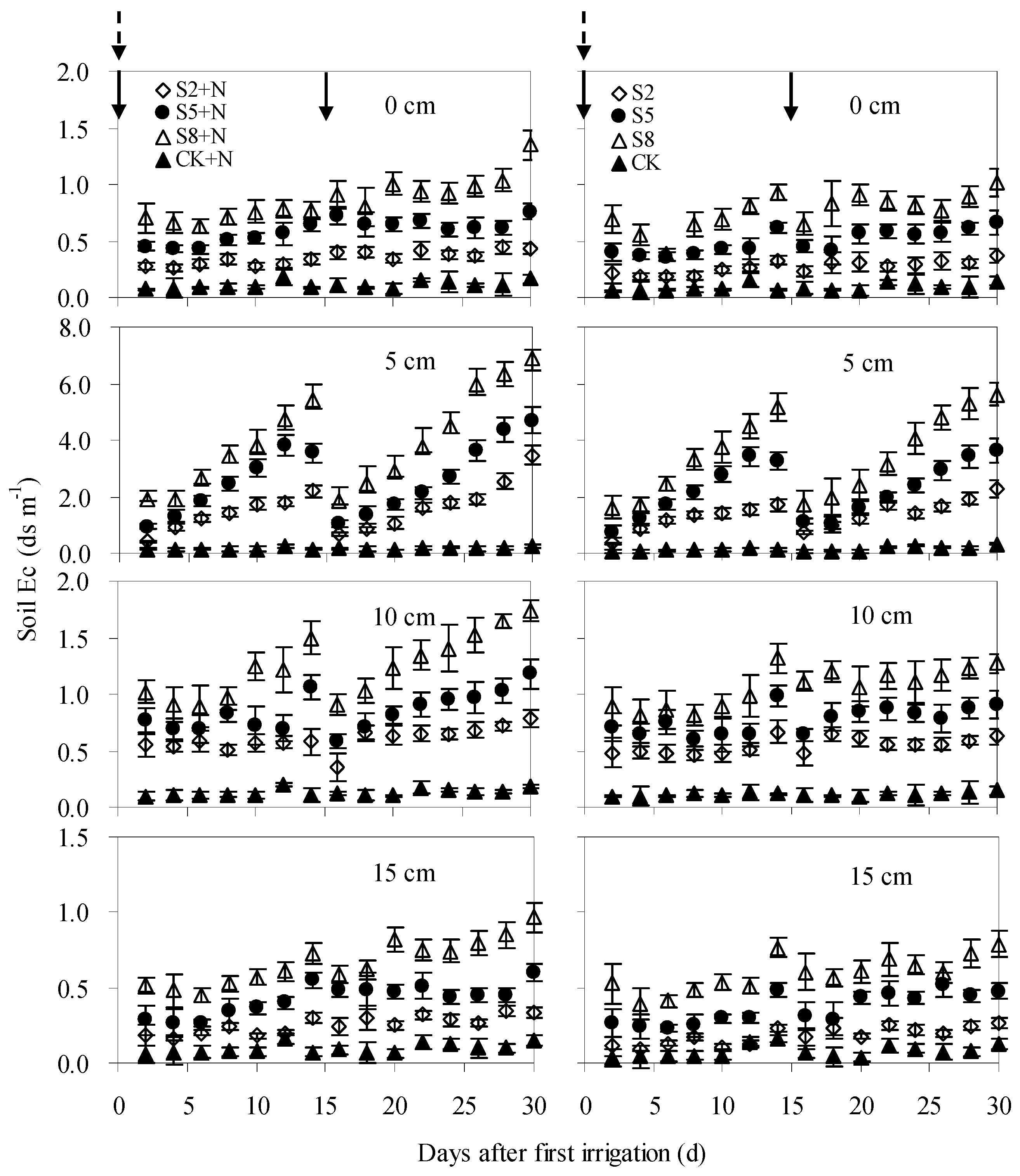

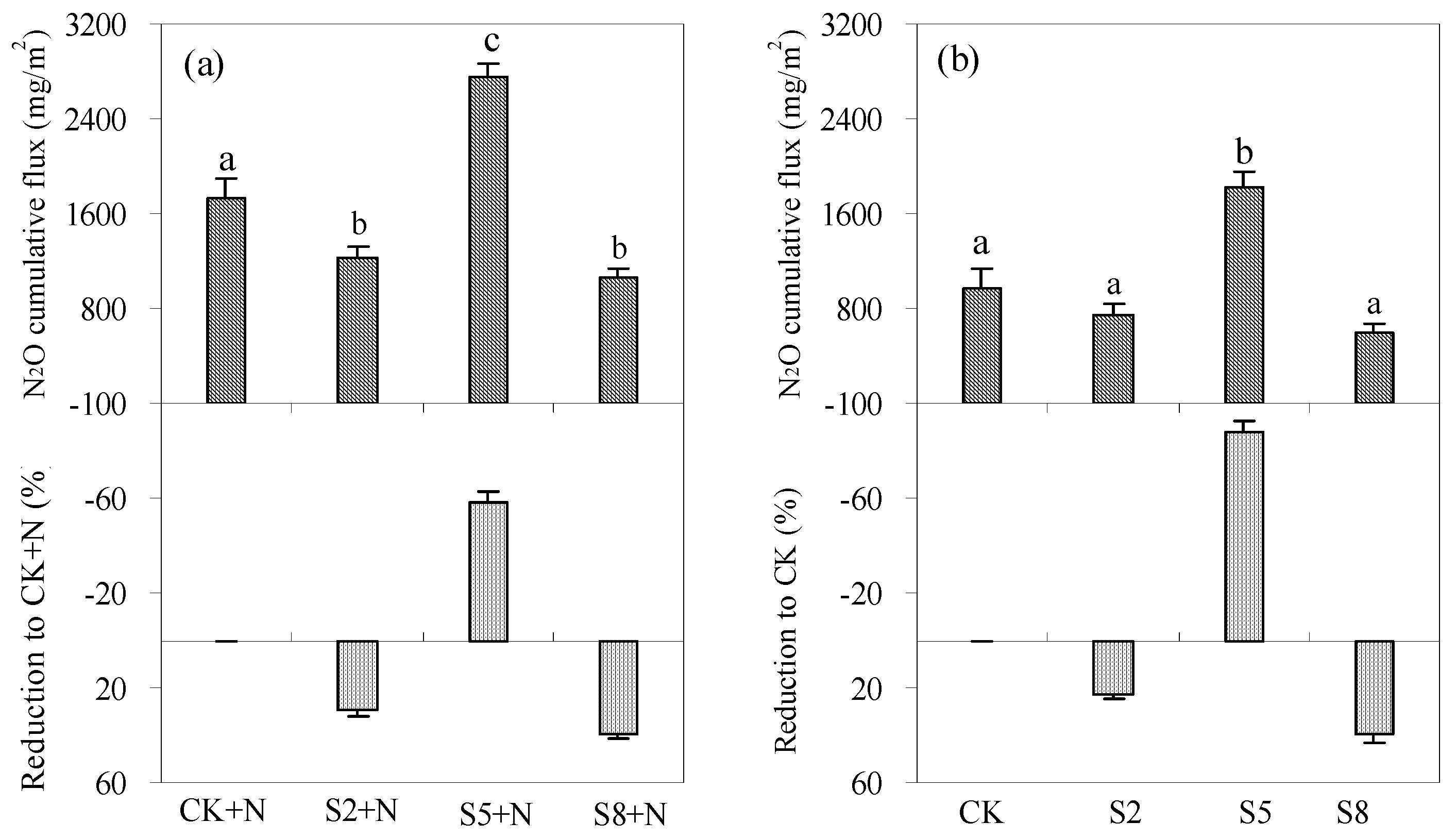
| Characteristic | Value |
|---|---|
| Clay (%) | 29 ± 1.1 |
| Silt (%) | 48 ± 1.7 |
| Sand (%) | 23 ± 0.9 |
| Ec (ds/m) | 0.4 ± 0.06 |
| pH (H2O) | 6.2 ± 0.1 |
| Organic matter (OM, g/kg) | 25.2 ± 0.3 |
| Total nitrogen (TN, g/kg) | 1.4 ± 0.02 |
| Total phosphorus (TP, g/kg) | 0.04 ± 0.01 |
| Nitrate nitrogen (NO3−-N, mg/kg) | 34.2 ± 2.9 |
| Ammonium nitrogen (NH4+-N, mg/kg) | 8.8 ± 0.7 |
| Treatments (n = 3) | N2O Fluxes (μg N2O/(m2h)) | ||||
|---|---|---|---|---|---|
| Pulse Period | Non-Pulse Period | Pulse Period | Non-Pulse Period | The Whole Period | |
| 20 July–26 July | 26 July–2 August | 2 August–9 August | 9 August–18 August | 20 July–18 August | |
| S2 + N | 5305.9 ± 432.5a | 100.0 ± 21.2a | 1687.9 ± 252.9a | 181.8 ± 22.7a | 1709.8 ± 142.4a |
| (72.4%) | (1.4%) | (23.0%) | (3.2%) | (100%) | |
| S5 + N | 7346.6 ± 637.4b | 121.0 ± 27.8a | 6577.8 ± 656.3b | 1802.4 ± 203.5b | 3818.0 ± 324.8b |
| (44.9%) | (0.7%) | (40.2%) | (14.2%) | (100%) | |
| S8 + N | 5024.2 ± 341.7a | 79.9 ± 16.4a | 958.6 ± 90.4c | 175.0 ± 21.0a | 1467.2 ± 101.7a |
| (79.9%) | (1.3%) | (15.2%) | (3.6%) | (100%) | |
| CK + N | 6132.1 ± 475.8a | 181.1 ± 23.1b | 2770.2 ± 213.7d | 974.6 ± 67.4c | 2411.8 ± 159.9c |
| (60.4%) | (1.9%) | (32.5%) | (5.2%) | (100%) | |
| S2 | 3353.1 ± 245.9a | 77.5 ± 11.2a | 969.8 ± 78.4a | 54.9 ± 11.2a | 1043.2 ± 95.8a |
| (75.0%) | (1.7%) | (21.7%) | (1.6%) | (100%) | |
| S5 | 6476.8 ± 432.1b | 136.2 ± 21.0ba | 2938.4 ± 202.6b | 1008.1 ± 104.3b | 2531.1 ± 286.7b |
| (59.7%) | (1.2%) | (27.1%) | (12.0%) | (100%) | |
| S8 | 2108.6 ± 157.9a | 64.8 ± 11.8a | 1134.2 ± 107.0a | 141.6 ± 20.6a | 814.3 ± 78.5a |
| (60.4%) | (1.9%) | (32.5%) | (5.2%) | (100%) | |
| CK | 3042.3 ± 272.3c | 110.4 ± 14.0b | 1863.3 ± 126.2c | 594.3 ± 32.4c | 1348.7 ± 91.4a |
| (52.6%) | (1.9%) | (32.3%) | (13.2%) | (100%) | |
| Treatments | N2O V.S. WFPS | N2O V.S. Ec | ||
|---|---|---|---|---|
| Relation | Determine Coefficient (R2) | Relation | Determine Coefficient (R2) | |
| CK + N | y = 13.21e0.04x | 0.28 * | y = 2474e−11.70x | 0.07 ns |
| S2 + N | y = 12.50e0.07x | 0.66 * | y = 14966e−5.84x | 0.59 * |
| S5 + N | y = 76.87e0.05x | 0.34 * | y = 41004e−3.43x | 0.56 * |
| S8 + N | y = 20.41e0.05x | 0.47 * | y = 6988e−1.94x | 0.45 * |
| CK | y = 87.46e0.04x | 0.26 * | y = 2980e−15.53x | 0.15 ns |
| S2 | y = 10.82e0.06x | 0.58 * | y = 42015e−8.69x | 0.57 * |
| S5 | y = 60.36e0.05x | 0.44 * | y = 56362e−4.26x | 0.55 * |
| S8 | y = 14.75e0.05x | 0.57 * | y = 14766e−2.73x | 0.61 * |
| Irrigation Events | Treatment | N2O Peak Fluxes (μg N2O/(m2h)) | WFPS (%) | Ec (ds/m) | T (°C) |
|---|---|---|---|---|---|
| After first irrigation (20 July–1 August) | S2 + N | 20,509.1 ± 1095.9 | 74.6 ± 6.1 | 0.47 ± 0.08 | 36.8 ± 0.4 |
| S5 + N | 24,795.4 ± 1178.5 | 74.4 ± 5.9 | 0.68 ± 0.10 | 36.4 ± 0.5 | |
| S8 + N | 16,312.2 ± 808.4 | 76.3 ± 6.3 | 0.99 ± 0.12 | 36.7 ± 0.3 | |
| CK + N | 22,926.2 ± 1252.9 | 72.1 ± 5.6 | 0.10 ± 0.03 | 37.0 ± 0.4 | |
| S2 | 13,492.5 ± 618.9 | 70.9 ± 5.7 | 0.41 ± 0.06 | 36.3 ± 0.3 | |
| S5 | 21,245.7 ± 1139.9 | 71.5 ± 5.9 | 0.63 ± 0.09 | 36.4 ± 0.4 | |
| S8 | 7590.6 ± 322.3 | 72.4 ± 5.3 | 0.87 ± 0.12 | 37.0 ± 0.4 | |
| CK | 12,759.9 ± 631.7 | 68.9 ± 6.3 | 0.07 ± 0.02 | 37.3 ± 0.6 | |
| After second irrigation (2 August–18 August) | S2 + N | 3465.7 ± 589.0 | 75.2 ± 6.1 | 0.55 ± 0.08 | 31.0 ± 0.3 |
| S5 + N | 13,619.1 ± 1359.9 | 77.8 ± 5.9 | 0.79 ± 0.11 | 30.9 ± 0.2 | |
| S8 + N | 2655.8 ± 251.0 | 78.9 ± 4.3 | 1.22 ± 0.10 | 31.1 ± 0.4 | |
| CK + N | 5418.9 ± 275.6 | 73.6 ± 6.0 | 0.10 ± 0.02 | 31.3 ± 0.3 | |
| S2 | 2347.0 ± 223.2 | 76.8 ± 5.6 | 0.54 ± 0.08 | 31.1 ± 0.4 | |
| S5 | 4424.2 ± 359.9 | 75.7 ± 6.3 | 0.64 ± 0.09 | 31.1 ± 0.3 | |
| S8 | 2078.2 ± 275.6 | 78.4 ± 7.1 | 1.14 ± 0.12 | 31.4 ± 0.3 | |
| CK | 3304.2 ± 287.9 | 69.1 ± 6.8 | 0.07 ± 0.03 | 32.1 ± 0.5 |
| Experiment Type | Salt Type | Salinity Level | N Level (kg N/ha) | Cumulative N2O Flux | Conclusion | Reference |
|---|---|---|---|---|---|---|
| A pot experiment (30 d) | Nacl:Cacl2 (1:1) | 2, 5 and 8 g/L in water (S2, S5 and S8) | 0 | 5.9–18.2 kg/ha | S5 > CK > S2 > S8 | Current research |
| 120 | 10.6–27.5 kg/ha | S5 + N > CK + N > S2 + N > S8 + N | ||||
| A incubation experiment (28 d) | NaCl + NH4Cl | 0, 5.9, 11.7, 23.4 and 35.1 g/L in soil solution (S0, S5.9, S11.7, S23.4 and S35.1) | / | 96.3–169.6 ug/(g soil) | 65% WHC: S5.9 > S11.7 > S35.1 > S0 > S23.4 (ns) | [19] |
| Na2SO4 + (NH4)2SO4 | / | 205.5–322.7 ug/(g soil) | 65% WHC: S0 > S5.9 > S35.1 > S23.4 > S11.7 (ns) | |||
| Ca(NO3)2 | 0, 5.9, 17.6 and 29.3 g/L in soil solution (S0, S5.9, S17.6 and S29.3) | / | 122.5–699.8 ug/(g soil) | 70% WHC: S5.9 > S0 > S17.6 > S29.3 (ns) | ||
| A incubation experiment | Nacl | 2.5, 7.5, 10 g/L in water (S2.5, S7.5 and S10) | / | / | S10 (5.1) > S7.5 = S2.5 (2.2–2.3) (unit: mg/L) | [21] |
| A incubation experiment | Nacl | 0, 1, 3 and 6 g/(kg soil) (S0, S1, S3 and S6) | / | / | 20% moisture (w/w): S6 (0.5) < S3 (1.2) < S1 (2.8) (unit: ng/(kg h)) | [17] |
| A bean field experiment (84 d) | Nacl | 0.03 and 0.6 g/L in water (S0.03 and S0.6) | 120 | 0.5 and 0.4 kg/ha | S0.03 > S0.6 (ns) | [31] |
| 25 | 0.3 and 0.4 kg/ha | S0.03 < S0.6 (ns) | ||||
| A cotton field experiment (57 d) | Nacl:Cacl2 (1:1) | 0.4, 4.6 and 8.1 ds/m in water (C0.4, C4.6 and C8.1) | 0 | 0.1–~0.2 kg/ha | C0.4 < C4.6 < C8.1 | [22] |
| 360 | 0.3–0.4 kg/ha | C8.1 < C0.4 < C4.6 |
© 2018 by the authors. Licensee MDPI, Basel, Switzerland. This article is an open access article distributed under the terms and conditions of the Creative Commons Attribution (CC BY) license (http://creativecommons.org/licenses/by/4.0/).
Share and Cite
Wei, Q.; Xu, J.; Liao, L.; Li, Y.; Wang, H.; Rahim, S.F. Water Salinity Should Be Reduced for Irrigation to Minimize Its Risk of Increased Soil N2O Emissions. Int. J. Environ. Res. Public Health 2018, 15, 2114. https://doi.org/10.3390/ijerph15102114
Wei Q, Xu J, Liao L, Li Y, Wang H, Rahim SF. Water Salinity Should Be Reduced for Irrigation to Minimize Its Risk of Increased Soil N2O Emissions. International Journal of Environmental Research and Public Health. 2018; 15(10):2114. https://doi.org/10.3390/ijerph15102114
Chicago/Turabian StyleWei, Qi, Junzeng Xu, Linxian Liao, Yawei Li, Haiyu Wang, and Shah Fahad Rahim. 2018. "Water Salinity Should Be Reduced for Irrigation to Minimize Its Risk of Increased Soil N2O Emissions" International Journal of Environmental Research and Public Health 15, no. 10: 2114. https://doi.org/10.3390/ijerph15102114
APA StyleWei, Q., Xu, J., Liao, L., Li, Y., Wang, H., & Rahim, S. F. (2018). Water Salinity Should Be Reduced for Irrigation to Minimize Its Risk of Increased Soil N2O Emissions. International Journal of Environmental Research and Public Health, 15(10), 2114. https://doi.org/10.3390/ijerph15102114






